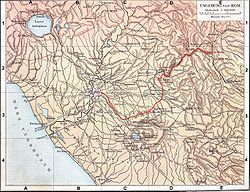Aqua Marcia





The Aqua Marcia (Italian: Acqua Marcia) is one of the longest of the eleven aqueducts that supplied the city of Rome. The aqueduct was built between 144–140 BC, during the Roman Republic. The still-functioning Acqua Felice from 1586 runs on long stretches along the route of the Aqua Marcia.
Together with the Aqua Anio Vetus, Aqua Anio Novus and Aqua Claudia, it is regarded as one of the "four great aqueducts of Rome."[1]
It was the first to enter Rome on arches, which were used for the last 11 km, and which were also used later combined with the Aqua Tepula and Aqua Julia.
Route[]
The ancient source for the aqueduct was near the modern towns of Arsoli and Agosta, over 91 km (57 mi) away in the Anio valley. This general locale, in hills to the east of the city, was also used for other aqueducts including the Anio Vetus, Anio Novus, and Aqua Claudia. The same source is used today to supply the modern aqueduct.
The route was initially underground for about 80 km and then emerged on large monumental arches.
The initial stretch of the aqueduct flanked the right bank of the river Anio, crossing it with a bridge just before Vicovaro and joining the route of the Aqua Anio Vetus (at a lower altitude). It continued towards Tivoli and then, bypassing the Tiburtini Mountains, it reached via Prenestina. After the current municipality of Gericomio it crossed the Gallicano area in Lazio with alternating bridges (of which many are visible) and underground sections. After the Capannelle area it headed directly to Rome and surfaced at the seventh mile of the Via Latina, where there was a limaria pool (settling basin). From here a stretch of about 9 km arches flanked the Via Latina and reached Rome in the locality ad spem veterem, near Porta Maggiore, where other aqueducts met. From here it followed the future Aurelian walls until it crossed via Tiburtina on an arch later transformed into Porta Tiburtina. The route passed the Viminal gate, where Termini Station stands today, and ended near the Collina gate, where the main castellum aquae for distribution stood, near the current Via XX Settembre. The main branch of the subsequent network (which covered 2/3 of the city) reached the Quirinal and then the Capitol, while a secondary branch (rivus Herculaneus), which started from the Tiburtina gate, served the Caelian and the Aventine.
Its extension to the Capitoline Hill caused a controversy at the time, because traditionalists were concerned about a passage in the Sibylline Books warning against bringing water there.[2]
History[]
The Aqua Marcia was constructed from 144 to 140 BC by the praetor Quintus Marcius Rex (an ancestor of Julius Caesar), for whom it is named and whose judiciary role was extended for the completion of the work.
The aqueduct was largely paid for by spoils from the recent Roman conquests of Corinth in 146 BC and the destruction of Carthage at the end of the Third Punic War, in the same year.[3]
The aqueduct followed the via Tiburtina into Rome, and entered the city in its eastern boundary at the Porta Tiburtina of the Aurelian Wall. It was well known for its cold and pure waters.
The aqueduct was repaired by Marcus Agrippa in 33 BC, and then later again by Augustus, according to the inscription in the arch that was later made into the Porta Tiburtina. Augustus also augmented the supply by linking it to an additional source, the Aqua Augusta, doubling the throughput. Much of its supply was siphoned off by private citizens for their own use, making it effectively only a trickle in the city by the time of Nero. The supply was increased again by later emperors. Frontinus measured the flow of the Aqua Marcia at its source around AD 97 as 4690 quinariae,[4] making it the second-greatest source of the city's water. Modern estimates of size of one quinaria vary over a wide range, from 10,000 l (2,600 US gal; 2,200 imp gal) to 76,800 l (20,300 US gal; 16,900 imp gal) of water a day,[5] giving the Aqua Marcia a flow rate of 46,900,000 l (12,400,000 US gal; 10,300,000 imp gal) to 360,192,000 l (95,153,000 US gal; 79,231,000 imp gal) of water a day.
See also[]
- List of aqueducts in the city of Rome
- List of aqueducts in the Roman Empire
- List of Roman aqueducts by date
- Parco degli Acquedotti
- Ancient Roman technology
- Roman engineering
References[]
- ^ Blackman, Deane R. (1978). "The Volume of Water Delivered by the Four Great Aqueducts of Rome". Papers of the British School at Rome. 46: 52–72. doi:10.1017/S0068246200011417. JSTOR 40310747.
- ^ Stambaugh 1988, p. 37.
- ^ Stambaugh 1988, p. 36.
- ^ Rodgers, Robert (2004). Frontinus. De aquaeductu urbis Romae. Edited with an introduction and commentary by R. H. Rodgers. Cambridge: Cambridge University Press. p. 67. ISBN 0-521-83251-9. Retrieved 16 October 2018.
- ^ Keenan-Jones, Duncan; Motta, Davide; Garcia, Marcelo H.; Fouke, Bruce W. (2015). "Travertine-based estimates of the amount of water supplied by ancient Rome's Anio Novus aqueduct". Journal of Archaeological Science: Reports. 3: 1–10. doi:10.1016/j.jasrep.2015.05.006.
Bibliography[]
- Coarelli, Filippo, Guida Archeologica di Roma, Arnoldo Mondadori Editore, Milano, 1989.
- Claridge, Amanda, Rome: An Oxford Archaeological Guide, Oxford University Press, New York, 1998
- Stambaugh, John E (1988). The Ancient Roman City. Johns Hopkins University Press. p. 395. ISBN 9780801836923.
External links[]
- Aqua Marcia entry on the Lacus Curtius website
- Information on Roman aqueducts
- (in Italian) Map of Roman aqueducts
| Wikimedia Commons has media related to Aqua Marcia (Rome). |
- Buildings and structures completed in the 2nd century BC
- Classical aqueducts in Rome

